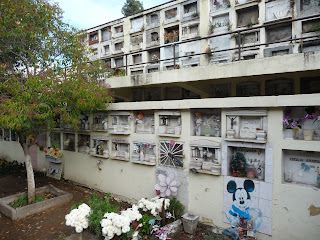La Serena was our next stop after our language course in Valparaíso.
We did not sleep much during our six hour bus drive from Valparaíso, but we immediately felt awake as we started carrying our bags from the bus station to our hostel very early in the morning. A nice German receptionist let us have a nap at the hostel's terrace. After resting and having a good breakfast we started exploring the city. The weather treated us very well and we enjoyed the town a lot. We got a map at the friendly information center and walked to the local lighthouse.
 |
| Lighthouse in La Serena |
In the evening we did some planning, so on Monday we could depart to Humboldt Penguin National Reserve. The bus ride was super cool. The privately operated microbus serves as the main connection of people in distant villages with the rest of civilization and is also responsible for bringing newspapers and essential supplies.
It was quite cold and windy at the reserve and I got a bit sea sick. But all these troubles were compensated by all the animals we saw: dolphins, penguins, sea lions, ....
 |
| Humboldt Penguins believe that you can not see them when they turn their backs to you |
After the boat ride we stopped for one hour at Isla Dama, where we enjoyed a beautiful walk.
 |
| Beach at Isla Dama |
The next morning we took a bus to Vicuña. Vicuña is a small village in the Elqui valley. It is an ideal place for astronomy as it has only 60 cloudy days a year and of course we enjoyed the beautiful sunny day there. After booking our trip to the Mamalluca observatory, we climbed a small hill next to Vicuña.
 |
| Mountains around Vicuña |
In the evening we had a wonderful tour to the observatory. Our guide was very knowledgable and enthusiastic, and was happy to answer all our questions. We saw many stars using telescopes, but Saturn was especially wonderful to see. We then moved outside and our guide showed us some constellations using a laser pointer. I quickly learned about the Southern Cross, which is still somehow fascinating for me. Close to the end of the tour, the guide even took a picture of the moon for us using the telescope.
 |
| Laura looking at Saturn |
 |
| Moon via telescope |
On Wednesday we searched for some hiking/trekking possibilities in the Elqui valley. Realizing that we were in a desert and water is not easily available, we decided to pass on hiking. Instead we visited the Gabriela Mistral museum (another famous poet from Chile) and took a bus to La Serena. The tickets to San Pedro for that night were sold out, so we bought tickets for next day and stayed one more day in La Serena. On the next day we visited Coquimbo, but unfortunately had only two hours to visit this town.
 |
| Small fortress at Coquimbo |
 |
| Sea lions in Coquimbo |
In the afternoon we took a bus to San Pedro de Atacama. We hope to tell you about it soon, but before that you can take a look on more pictures.















